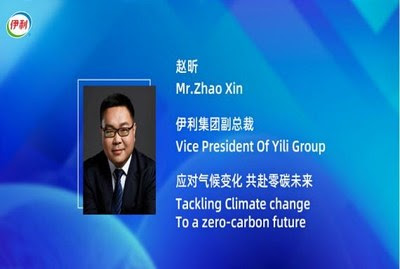شرم الشيخ، مصر، 15 نونبر/تشرين الثاني 2022 / PRNewswire / — انعقدت الدورة السابعة والعشرين لمؤتمر الأطراف في اتفاقية الأمم المتحدة الإطارية بشأن تغير المناخ ( COP27 ) في شرم الشيخ بمصر، ولفتت الانتباه في جميع أنحاء العالم. في 8 نونبر/تشرين الثاني، استضاف مركز المعرفة الدولية حول التنمية في الصين “ندوة حول تنمية الطاقة النظيفة – تسريع الإنجاز بشأن طاقة نظيفة وبأسعار معقولة (هدف التنمية المستدامة السابع 7)” في جناح الصين. وانضم ممثلو المنظمات والمؤسسات الدولية إلى مناقشات المائدة المستديرة حول “الممارسات الخضراء للشركات والفرص في سلسلة إمداد الطاقة المتجددة”.

تمت دعوة Yili لحضور الندوة عبر الإنترنت كممثل عن صناعة المنتجات الغذائية في الصين. تم عرض قصة حليبها الرائد الخالي من الكربون في تقرير الاستهلاك المستدام: إجراءات الشركات الصينية.
اتخاذ إجراءات من أجل التنمية الخضراء
في انعكاس لالتزام الصين بتحقيق ذروة الكربون وحياد الكربون بحلول عامي 2030 و 2060، بدأت الشركات الصينية بالمثل في اتخاذ زمام المبادرة. اقترح بان جانج، رئيس مجلس الإدارة ورئيس مجموعة Yili ، مبدئيًا مفهوم “القيادة الخضراء” في عام 2007 وقدم “سلسلة الصناعة الخضراء” في أعمال الألبان في الصين في عام 2009. في عام 2022، كانت شركة Yili هي الأولى في قطاع الأغذية في الصين في إطلاق خطتها لمستقبل خالٍ من الكربون وخريطة طريق لمستقبل خالٍ من الكربون. تخطط مجموعة Yili مسلحة بهذه الاستراتيجية، لتحقيق حيادية الكربون على مستوى السلسلة الصناعية بحلول عام 2050، مع تشكيل «تحالف صافي الكربون الصفري» مع شركاء مشابهين في التفكير من جميع أنحاء العالم.
النهوض بخفض الكربون على نطاق السلسلة
يشمل قطاع الألبان الصناعات الأولية والثانوية والثالثية من زراعة الأعلاف إلى البيع. تعمل مجموعة Yili على تطوير نظام زراعي متكامل تم تطبيقه على 272 مرعى شريكة بحلول نهاية عام 2021. تروج Yili للتصنيع الأخضر في مصانعها من خلال تعزيز كفاءة الطاقة، واستخدام الطاقة المتجددة، واستخدام مواد تغليف صديقة للبيئة. لم تمر جهود المجموعة مرور الكرام. صنفت وزارة الصناعة وتكنولوجيا المعلومات الصينية 23 فرعا وشركات تابعة لها على أنها “مصانع خضراء”. في وقت سابق من هذا العام، أطلقت Yili منتجات سلسلة خالية من الكربون بشكل رسميا.
الدعوة إلى أسلوب حياة أخضر منخفض الكربون
أصبحت المنتجات الخضراء والمستدامة أكثر شعبية في السنوات الأخيرة. تنقل Yili مفهوم تقليل الكربون إلى الجمهور من خلال حملات مختلفة. “يمثل حليب Yili الخالي من الكربون خطوة أخرى لتطوير منخفض الكربون في صناعة الألبان في الصين ويقترح طريقًا جديدًا للمضي قدمًا من حيث تعزيز أنماط الحياة والاستهلاك منخفض الكربون”، وفقًا لما ذكره هان بين، الأمين العام التنفيذي لشبكة الاتفاق العالمي للأمم المتحدة في الصين.
يتم الاعتراف بممارسات Yili في التنمية المستدامة من قبل أطراف ثالثة. تم تضمين حالاتها في المسار نحو تحقيق صافي صفري: ممارسات أهداف التنمية المستدامة للمؤسسات في الصين من قبل برنامج الأمم المتحدة الإنمائي والمسار نحو تحقيق صافي صفري للشركات من خلال الاتفاق العالمي للأمم المتحدة. قال جيانغ شيهينج، نائب رئيس مركز المعرفة الدولية للتنمية، أنه من المتوقع أن تقود Yili صناعة الألبان لجعل أهداف الوصول إلى الذروة الكربونية وحياد الكربون حقيقة في الصين.
رابط الصورة المرفقة:
الرابط: http://asianetnews.net/view-
التعليق على الصورة: خطة مجموعة Yili نحو مستقبل صافي الصفر
الرابط: http://asianetnews.net/view-
التعليق على الصورة: مؤتمر جناح الصين COP27
الرابط: http://asianetnews.net/view-
التعليق على الصورة: حضر نائب الرئيس تشاو شين مناقشة المائدة المستديرة.
الصورة – https://mma.prnewswire.com/
الصورة – https://mma.prnewswire.com/
الصورة – https://mma.prnewswire.com/
